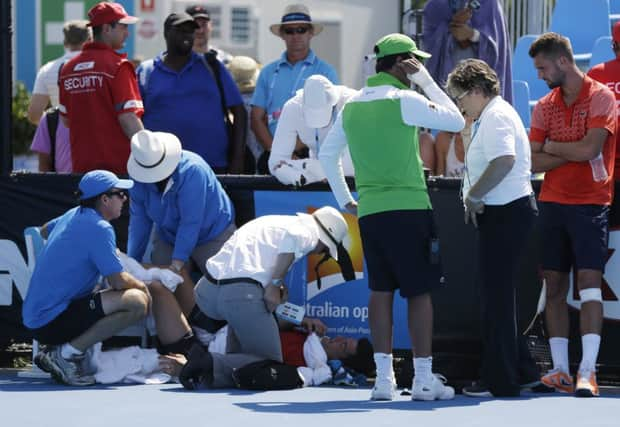Tennis stars at boiling point in Australian Open


The decision to carry on with play saw tournament organisers come in for criticism from players, with one describing the conditions as “dangerous” and “inhumane”.
Wimbledon champion Andy Murray was among those to question the wisdom of holding matches in such high temperatures, stating that the image of people collapsing looked “terrible” for the sport.
Advertisement
Hide AdAdvertisement
Hide AdThe day’s peak temperature was 42.2C. Although that fell short of Melbourne’s January record of 45.6C, it made for testing conditions on court.
Players tried to cool off between points by placing bags of ice on their heads or draping them over their necks, but some were still struck down by the unseasonably warm weather.
Canadian qualifier Frank Dancevic said he started feeling dizzy in the first set of his match against Benoit Paire before collapsing in the next set. After receiving medical attention, he returned to the match, but lost in straight sets.
“I couldn’t keep my balance any more and I leaned over the fence, and when I woke up people were all around me,” he said.
“I think it’s inhumane, I don’t think it’s fair to anybody, to the players, to the fans, to the sport, when you see players pulling out of matches, passing out,” the Canadian said.
“It’s hazardous to be out there. It’s dangerous. Until somebody dies, they’re just going to keep playing matches in this heat.”
Danish former world number one Caroline Wozniacki enjoyed a straight-sets victory in the morning when the temperature reached 38C.
She compared the experience to “playing in a sauna” and revealed her water bottle had started to melt in the heat. “I put the bottle down on the court and it started melting a little bit underneath – the plastic. So you know it was warm.”
Advertisement
Hide AdAdvertisement
Hide AdTwo-time defending champion Victoria Azarenka agreed, stating: “It felt pretty hot, like you’re dancing in a frying pan or something like that.”
Murray, who beat Japan’s Go Soeda 6-1, 6-1, 6-3, said the conditions raised questions. “As much as it’s easy to say the conditions are safe, it only takes one bad thing to happen.
“It looks terrible for the whole sport when people are collapsing, ball kids are collapsing, people in the stands are collapsing. That’s obviously not great.
“Whether it’s safe or not I don’t know, but you’ve got to be very careful. There have been issues in other sports with players collapsing and you don’t want to see anything bad happen to anyone,” he said.
Serbian Jelena Jankovic, a former Wimbledon mixed doubles champion, burnt her bottom on an uncovered seat.
She agreed with Dancevic that the heat made a mockery of one of the most renowned events in tennis.
“For the health of the players they should have a temperature where you don’t play,” she said. “It doesn’t matter how good a player you are, sometimes your body can’t cope with this. It’s not easy and you can’t enjoy playing when you are ready to explode and are red in the face.”
A ball girl was treated for heat stress during a morning match, and the tournament shortened rotations for the ball boys and ball girls from an hour to 45- minute shifts.
Advertisement
Hide AdAdvertisement
Hide AdHowever, officials have played down the health risks, saying the majority of matches were completed without calls for medical attention.
The tournament has not yet invoked its extreme-heat policy, which would see outdoor matches suspended and roofs of two arenas closed.
Such a decision would be based on a formula of air temperature, humidity and wind speed to determine appropriate exposure levels to heat.
Tim Wood, the tournament’s chief medical officer, said: “Of course there were a few players who experienced heat-related illness or discomfort, but none required significant medical intervention after they had completed their match.”